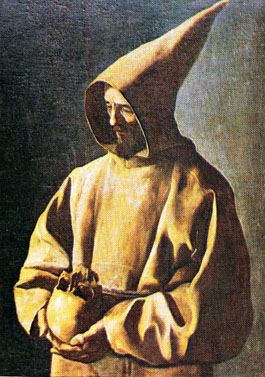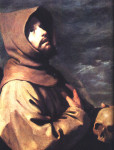
Francesco de Zurbaran (attributed to)
Spanish, 1598-1669
Franciscan Monk Meditating on a Skull, n.d. (17th c.)
Oil on canvas
38 1/4 x 28 1/8"
Gift of Katherine Harvey, Wright S. Ludington, Mr. and Mrs. Sterling Morton, and Mrs. Eugene L. Patterson
1954.1

One of the many Franciscan Monks Zurbaran as commissioned to paint. St. Francis of Assisi, 1659, Alte Pinakothek, Munich, Germany.
RESEARCH PAPER
This painting is circa 1630 to 1640 and is related to the whole series of individual standing figures of monks and saints which were the best and most representative works of Francesco Zurbaran. It was given to the museum in 1954 by Mr. & Mrs. Sterling Morton, Mrs. Eugene L. Patterson, Miss Katherine Harvey and Wright S. Ludington. It is “attributed” to Zurbaran because it has not been established with certainty that it is by the hand of that artist. We do know that at the peak of his career he maintained a large workshop in order to satisfy the many commissions he had when he was very popular. So it was not unusual for a picture to be partly by his hand, or perhaps painted in his style and according to his design, but by one of his assistants. This is not an easy thing to establish and so the Santa Barbara Museum of Art has taken the usual curatorial precaution of calling this a painting “attributed” to Zurbaran.
The artist was born in 1598 to a peasant family in a provincial area of Spain. Ten years earlier the Spanish Armada had been defeated by the English and the greatness of Spain was in decline. The 16th C had been a period of considerable prosperity, based on the discoveries and exploitations of the New World. It was the Spain of Philip II, who was a marvelous bureaucrat and a very strong king, but also a religious fanatic who created an atmosphere in his country for very stern and puritanical religious practice. He and his descendants maintained a sober appearance and lived an ascetic life style. Thousands of monasteries were established throughout Spain. It has been estimated that in the 1630s there were approximately 9,000 functioning monasteries and that one out of forty people was either a monk or a nun. In the 1620s Cardinal Richelieu of France was gradually gaining ascendancy over Spain and encouraging the Catalonians and other provinces of Spain to rebel against the centralized king – so there was economic decline and considerable political pressure at this time.
As a young man of 16, Zurbaran was sent to Seville in1614 to study art. Seville was a city through which much of the commerce of the New World was filtered, so it was a very affluent and active city with many religious orders there. By 1630 he had developed a painting style based on late Mannerism, which was current in the 16th century in the vicinity of Seville. He also must surely have been aware, in a city as cosmopolitan as Seville, of the painting of the Italian tenebrists, of the Caravaggio style painters, and also the painting of Ribera, El Greco and the young Velazquez – all established artists at that time – and he formed his own interpretation of a kind of Italian “naturalism”. This is in quotation marks because, while the subjects were painted in a naturalistic way, they are lit very dramatically, not the way that they would be seen in an ordinary room or an ordinary setting. Zurbaran formed his own interpretation of a strong figure, or few figures, grouped before a plain background and lit by a strong light, which clearly defines all the folds and creates a sense of a very solid 3 dimensional form in the pictorial space.
There is something very direct, clear and forceful about his painting style, which, even if it does deal with religious subjects, speaks a lot to modern sensibilities.
In the 1630s he received a considerable number of commissions from monasteries and religious orders we do not even know about today. He painted over 40 Franciscan monks and most of them are single views. St Francis himself is customarily identified by the presence of the stigmata, the obvious wound of the crucifixion, which St. Francis supposedly wore on his hands; and that does not appear here. However, this is a standard representation for Franciscan monks – standing and meditating on a skull. The Council of Trent in 1545 had established the Jesuits as a spearhead of reform of the church, and the Jesuits recommended the spiritual exercise of solitary meditation, actually suggesting that this be done while contemplating a skull. It was Zurbaran’s great skill to be able to suggest in these paintings a state of mind and soul which is very subtle and complex, yet he does it through very simple pictorial means and suggests the profound religious emotion of a contained, inward-looking person.
With the 1640s and the ongoing economic decline of Spain, the monastic commissions were to decline and there were revolts and other historical factors which affected Zurbaran’s career. He was invited in 1634 to go to Madrid as a painter to the King to do a series of, for him, very untypical representations of the Labors of Hercules for the Buena Retiro palace, and he was the only non-Madrid painter to be so honored. So apparently he enjoyed a national reputation at that time and also the friendship of Velazquez, who was painter extraordinary to the king. Rising stars such as Murillo, however, were establishing a new, much more sentimental and florid religious style which eclipsed Zurbaran’s and put him out of fashion. There is a sense in his later painting that he was trying to emulate Murillo, but this was not very successful and he gradually dropped from favor. He ended his life in relative obscurity and in poverty, painting commissions for South American convents. He died in Madrid in 1664.
In many ways Zurbaran’s career reflects and parallels the history of Spain which was in a period of decline and was to drop out, eventually, as a world power. Yet there is no doubt that he was one of the outstanding exponents of 17th century Spanish Realism and “Franciscan Monk Meditating on a Skull” is a very fine example of his work.
Prepared by Jadzia McDonough, March 2006
Much of the text is an edited version of a lecture given by Robert Henning, onetime Curator of Collections at SBMA (date unknown). The lecture was originally taped and transcribed by Pat Banks for the Docent Council.
SBMA CURATORIAL LABELS
Giovanni Paolo Panini was an Italian painter working at the height of the Grand Tour era, where gentlemen, typically from England, would travel through the European continent finishing their education. Highlights of the Grand Tour included visiting ancient Roman ruins in cities like Rome and Pompeii. The admiration for Greco-Roman art and architecture was such an integral part of a classical education that gentlemen on the Grand Tour would often take home paintings such as this one depicting scenes of famous buildings, fantastically combined into a single picture as a reminder of their trip.
- Ludington Court Reopening, 2021
